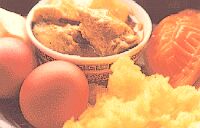Recipe Ingredient
- Sift:
- 400g glutinous rice flour
- 1 1/2 tbsp cornflour
- 150g steamed sweet potato, mashed
- 5 tbsp castor sugar
- 3 tbsp corn oil
- Combine:
- 250ml boiling water
- A little orangy red colouring (mix a little of red and orange colouring)
- Banana leaves trimmed into small round circles to line the angkus, lightly oiled.
- Filling:
- 400g split, skinned mung beans (green beans), wash and soak overnight, drain well.
- 300g castor sugar
- 2 tbsp corn oil
- 2 shallots, thinly sliced
- 1/2 tsp salt
Instructions
- Steam mung beans for 30 to 40 minutes. Mash through a wire sieve or blend until fine whilst hot and leave aside.
- Heat a non-stick saucepan with oil, fry shallots till golden brown then discard the shallots, leaving the aromatic oil in the saucepan. Add sugar and cook, stirring constantly until sugar dissolves and turns syrupy.
- Add mung beans and salt and stir-fry until it doesn´t stick to the sides of the pan. Remove and set aside to cool. Divide into small equal balls for the filling. Refrigerate until required.
- The skin: Put sifted ingredients and sugar in a large mixing bowl. Make a well in the centre, add sweet potatoes, corn oil and coloured water. Mix and knead into a shiny and pliable dough.
- Divide dough into equal portions. Roll each piece into a ball and flatten slightly. Place some filling in each piece of dough. Pinch and seal the edges to form round shapes.
- Lightly dust angku mould with glutinous rice flour. Press the base of filled dough into the mould. Knock or tap mould lightly on the surface of the table to dislodge the angku.
- Place angku on oiled banana leaf circles and steam, covered, over rapid boiling water for 4 to 5 minutes. Remove the lid from the steamer and continue to steam for a further 6 to 7 minutes or until cooked.
- Remove and brush lightly with corn oil.
- An angku mould has three different patterns. Use the angku or peach-shaped pattern.






